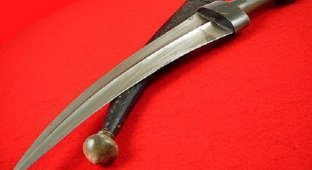How it was. Part 11. Polearm throwing weapons (11 photos)
I present to you a small selection of armor and weapons. I warn the lazy people at once there are not just a lot of letters, but a lot. For aesthetes, I want to add - it has not been read or verified. So you are not welcome here.

So the next topic is polearm throwing weapons. Dartik (Russian name sulitsa) is a throwing weapon, which is a spear, somewhat smaller and lighter compared to spears for equestrian or hand-to-hand combat (usually has a total length of about 1.2-1.5 m) and appropriately balanced for throwing convenience. Darts have been used as weapons by troops of many peoples and countries of the world since ancient times. Darts appeared at the beginning of the Mesolithic, when people learned to attach tips made of bone and stone to the simplest spears. A leaf-shaped flint dart tip is one of the most widespread types of archaeological finds of the primitive world.

Soon a spear thrower (atlatl) was invented - a device that increased the arm's reach when throwing, which had the form of a plank with a stop for the end of the shaft or a belt loop. A dart thrown by hand flew up to 20 of its own lengths, and the use of a spear thrower made it possible to throw darts twice as far, although significantly less accurately. For this reason, the spear thrower was used by the inhabitants of the steppes, for whom the throwing range was most relevant.
The bow competed with darts everywhere, but never completely replaced them. The advantage of the dart was, first of all, that it occupied only one hand - in the other there could be, for example, a shield. Heavy darts, unlike arrows, retained their destructive power throughout the flight, and at short distances they were superior to arrows in accuracy. If the accuracy of a fired arrow was influenced by some factors that did not depend on the shooter, then the dart, in principle, could be thrown as accurately as desired. On the other hand, throwing a dart required a certain amount of space to swing, and you couldn’t have as many darts with you as there were arrows. Therefore, ultimately, the bow was still preferable, pushing throwing spears into the background.


Among the barbarians, only peoples who did not know how to make powerful bows armed themselves with darts, but later, with the spread of protective equipment, interest in darts increased again due to their better penetrating power and accuracy.
For example, the light infantry of ancient Greece, Macedonia and Rome rarely used throwing weapons other than darts: when attacking hoplites, darts were more likely to hit them in unprotected parts of the body. It was easier to pierce armor that was not too strong, such as canvas, leather or chain mail, with a dart. The Romans even used spear throwers.
Short javelins were also often used by cavalry - this allowed a mounted fighter to use one hand to control the horse, and, importantly, in battle, a dart could be snatched from a clip (“jid”) faster than a bow and arrow from a quiver.

Finally, in Europe, darts began to be actively used again from the end of the 13th century, when the shortage of iron, which was required incomparably more for the production of darts than for the production of arrows, was alleviated to some extent.
Darts can be divided into several types. The first, the most ancient, similar in characteristics to hunting samples of the Stone Age, include the lightest (0.2-0.3 kg) and long (up to 210 cm) throwing spears. Such darts provided maximum throwing range and accuracy and were often used with a spear thrower. However, in terms of their mass, they were close to heavy arrows, and the lower initial speed determined even worse penetrating ability compared to arrows.
Heavier throwing spears, designed to pierce armor, were close in their characteristics to universal spear models, but unlike them they could have armor-piercing tips and weights made of lead rings. With a moderate (150-180 cm) length, the weight of “average” darts ranged from 0.7-1.7 kg. The throw range averaged 25 meters.

Finally, some types of darts were specially designed to disable heavy shields. This was the Roman pilum, whose mass was 2-4 kg. The pilum consisted of a shaft and an iron tip, which, according to the original design, was equal in length to the shaft. The shaft was half inserted into the tip, so that the total length of the spear was approximately 2 meters. There were various modifications of the original type; the tip was made longer and shorter. Length with tip is about 2 meters, tip is 60-100 cm, tip diameter is about 7 mm.
When attacking, soldiers threw darts at the enemy from a distance of about 7-10 meters, but no more than 30. Even if the dart did not cause direct damage to the enemy, it got stuck in the shield, which created great inconvenience for the enemy in close combat. The pilum was specially thrown so that it would hit the enemy’s shield, the soft tip would get stuck in the shield and bend under the weight of the shaft, after which the arriving legionnaire would step on it with his foot and pull the enemy’s shield down, creating a gap for a piercing blow with a sword or spear. Even if the legionnaire did not have time to step on the pilum, the enemy was forced to throw his shield, since the pilum made movement very difficult. The maximum effect was achieved with the massive use of darts. The main problem in using darts was the very limited maximum ammunition of the thrower (maximum 8-10 pieces).

The darts used by cavalry (in particular, Russian) were significantly shorter - 70-120 cm in length. But their weight exceeded 0.5 kg, which made it possible to penetrate light protective equipment. Short darts were thrown over short distances - about 10-15 meters.
Separately, it is worth mentioning the darts - “plumbats”, which were worn in several pieces in the legionnaire’s shield. Darts of this type were distinguished not only by a lead weight, as can be understood from their name, but also by a very short shaft length - about 45 centimeters. Such a device made it easier to carry, but together with the lead weight it greatly shifted the center of gravity towards the tip, which made it necessary to use it to stabilize the tail. There were both light (0.2 kg) and armor-piercing (more than 0.7 kg) samples of this weapon. The pigs threw themselves at a distance of up to 60 m.


Well, the last type of polearm throwing weapon is the harpoon. Although it is more likely not a weapon, but a tool used for hunting. It looks like a dart. Its distinctive feature is that its heavy (up to several kilograms) tip, usually equipped with side teeth bent back, is loosely connected to the shaft and upon impact, hitting the body, it is easily separated from the shaft, remaining connected to it by means of an attachment to the middle his ropes. This greatly hinders the victim’s movements, also causing severe blood loss. And although a number of peoples used harpoons for their defense, harpoons were never in service with armies.


























